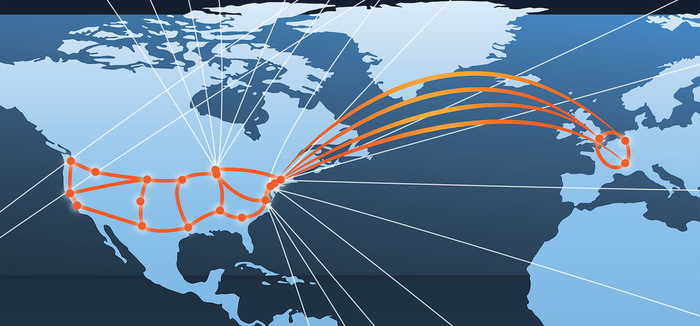'Father of the Internet' keen to explore commercial possibilities from 'astonishing' technology advances made by the revamped Energy Sciences Network in the US.

The latest version of the US Department of Energy's dedicated network for collaboration between the DOE's different research labs (comprising "premier" scientific instruments and supercomputers) has been formally unveiled.
The new iteration of the Energy Sciences Network, ESnet6, boasts 15,000 miles (24,000km) of fiber and 46.1 Tbit/s of bandwidth capacity. Network backbone links are capable of transferring data at speeds between 400 Gbit/s and 1 Tbit/s.
ESnet6, like its previous incarnations, connects DOE labs countrywide in a "data circulatory system" in the cause of collaborative scientific research.
The latest version, however, has significantly greater bandwidth capacity and greater agility in allocating network resources on request. Esnet5, when it was launched in 2011, offered a comparatively sluggish 100 Gbit/s.
Cerf calls in from New York
The ESnet6 unveiling ceremony, held at Berkeley Lab (where ESnet is headquartered), was attended by various DOE head honchos and federal government representatives, including Asmeret Asefaw Berhe, director of the DOE's Office of Science, and US congresswoman Barbara Lee.
One of the keynotes was given by Vint Cerf, chief Internet evangelist at Google (and ESnet policy board member). He is of course often called the "Father of the Internet" for his design contributions to TCP/IP protocols.
Figure 1:  Illustration of the ESnet6 backbone over a world map.
Illustration of the ESnet6 backbone over a world map.
(Source: Berkeley Lab)
Calling into California's Berkeley Lab from New York on a video link, Cerf spoke glowingly about ESnet6 and the team behind it.
"It is an astonishing accomplishment, and a turning point in design and architecture," he said. "This particular Esnet team has kept up with and in many cases pushed the envelope of commercially available resources."
Cerf noted approvingly the use of 400Gbit/s optical fiber capability per channel, and (like Google, he said) ESnet's keenness to adopt 800 Gbit/s per channel when kit becomes more readily available.
He seemed much more impressed, however, by ESnet6's capability to "do much more refined resource allocation" to meet different and varying demands. Previous ESnet versions, he said, didn't have that degree of flexibility.
"In the commercial community we'll obtain many lessons [from dynamic resource allocation]," Cerf continued. "We are watching with great interest, and I hope [will be] participating in taking advantage of what [the ESnet team] has learned."
He added, with an air of optimism, that he was "sure" that DOE and ESnet6 experts will be willing to share their findings with the likes of Google and other commercial companies, "because historically you have been a source of considerable insight in the design and implementation of designs like this."
ESnet6: Science Unbound from Berkeley Lab Computing Sciences on Vimeo.
Data explosion
ESnet's executive director, Inder Monga, told attendees at the opening ceremony that the volume of traffic over the network has been growing exponentially year-on-year since 1990. The only "minor blip" was in 2020 when the pandemic forced some of the DOE labs to shut down.
"For the past 12 months we moved around 1.4 exabytes of data," said Monga. "It took 28 years to reach 1 exabyte per year (2018), but in a couple of years we expect to do 2 exabytes per year. Data growth was one of the biggest drivers [for ESnet6} when we started the project [in 2016]."
The "critical industry partners" that worked alongside the ESnet6 team were AMD, Ciena, Infinera, Lumen Technologies and Nokia.
Related posts:
— Ken Wieland, contributing editor, special to Light Reading
About the Author(s)
You May Also Like











